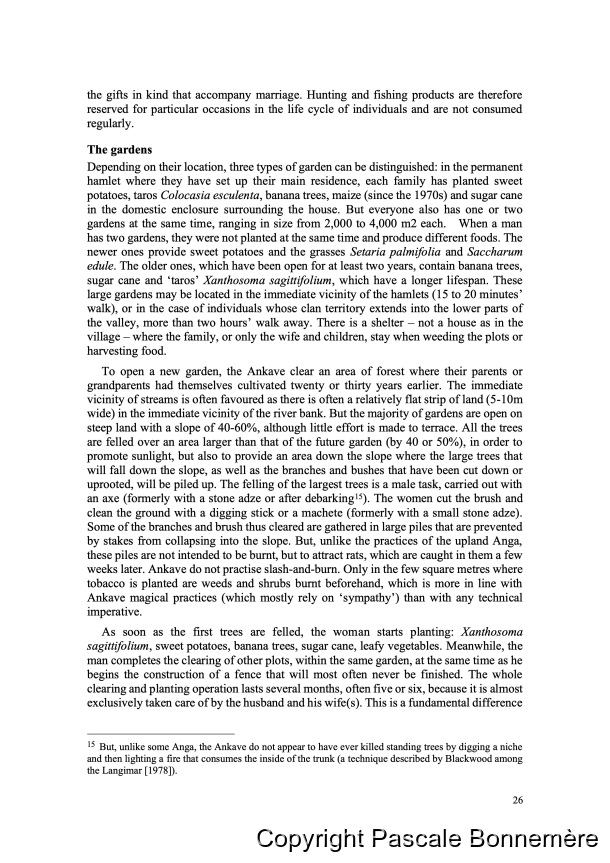|
|  [Note: this transcription was produced by an automatic OCR engine]
the gifts in kind that accompany marriage. Hunting and fishing products are therefore
reserved for particular occasions in the life cycle of individuals and are not consumed
regularly.
The gardens
Depending on their location, three types of garden can be distinguished: in the permanent
hamlet where they have set up their main residence, each family has planted sweet
potatoes, taros Colocasia esculenta, banana trees, maize (since the 1970s) and sugar cane
in the domestic enclosure surrounding the house. But everyone also has one or two
gardens at the same time, ranging in size from 2,000 to 4,000 m2 each. When a man
has two gardens, they were not planted at the same time and produce different foods. The
newer ones provide sweet potatoes and the grasses Setaria palmifolia and Saccharum
edule. The older ones, which have been open for at least two years, contain banana trees,
sugar cane and ‘taros’ Xanthosoma sagittifolium, which have a longer lifespan. These
large gardens may be located in the immediate vicinity of the hamlets (15 to 20 minutes”
walk), or in the case of individuals whose clan territory extends into the lower parts of
the valley, more than two hours’ walk away. There is a shelter — not a house as in the
village — where the family, or only the wife and children, stay when weeding the plots or
harvesting food.
To open a new garden, the Ankave clear an area of forest where their parents or
grandparents had themselves cultivated twenty or thirty years earlier. The immediate
vicinity of streams is often favoured as there is often a relatively flat strip of land (5-10m
wide) in the immediate vicinity of the river bank. But the majority of gardens are open on
steep land with a slope of 40-60%, although little effort is made to terrace. AI the trees
are felled over an area larger than that of the future garden (by 40 or 50%), in order to
promote sunlight, but also to provide an area down the slope where the large trees that
will fall down the slope, as well as the branches and bushes that have been cut down or
uprooted, will be piled up. The felling of the largest trees is a male task, carried out with
an axe (formerly with a stone adze or after debarking!$). The women cut the brush and
clean the ground with a digging stick or a machete (formerly with a small stone adze).
Some of the branches and brush thus cleared are gathered in large piles that are prevented
by stakes from collapsing into the slope. But, unlike the practices of the upland Anga,
these piles are not intended to be burnt, but to attract rats, which are caught in them a few
weeks later. Ankave do not practise slash-and-burn. Only in the few square metres where
tobacco is planted are weeds and shrubs burnt beforehand, which is more in line with
Ankave magical practices (which mostly rely on ‘sympathy”) than with any technical
imperative.
As soon as the first trees are felled, the woman starts planting: Xanthosoma
sagittifolium, sweet potatoes, banana trees, sugar cane, leafy vegetables. Meanwhile, the
man completes the clearing of other plots, within the same garden, at the same time as he
begins the construction of a fence that will most often never be finished. The whole
clearing and planting operation lasts several months, often five or six, because it is almost
exclusively taken care of by the husband and his wife(s). This is a fundamental difference
15 But, unlike some Anga, the Ankave do not appear to have ever killed standing trees by digging a niche
and then lighting a fire that consumes the inside of the trunk (a technique described by Blackwood among
the Langimar [1978]).
26
�
|